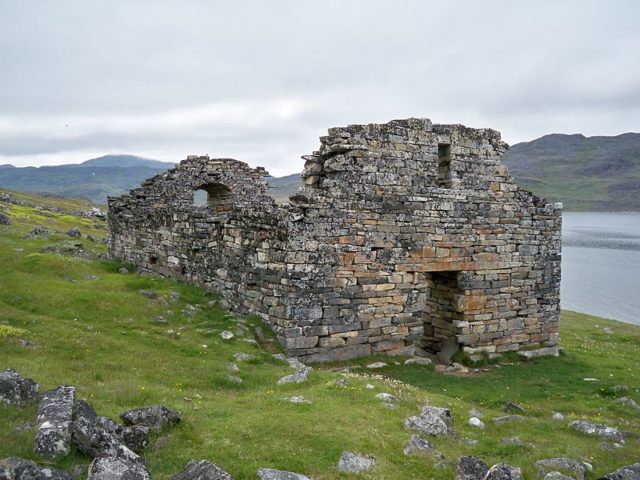
It is widely believed that Vikings were able to colonise Greenland because of a period of unusually warm weather.
Around 985 AD, Erik the Red, leading a group of Vikings, first landed in southwestern Greenland after sailing from the recently-settled Iceland. Experts believe that at their peak there were around 5,000 Vikings living on the island, but the settlement died out between 1360 and 1460 AD.
The Vikings’ arrival coincided with the period of warm weather across Europe, and their disappearance occurred right at the onset of the Little Ice Age. They left only ruins behind and a longstanding mystery as to what happened. Although the Vikings vanished, the native Inuit remained, and it wasn’t until the 1700s that Europeans resettled on Greenland.
Researchers have long believed that the Vikings were able to colonize Greenland because of the unusually warm weather. Now, with new evidence, experts are revising this opinion. The evidence suggests that the climate was just as cold when the Vikings arrived as when they disappeared.
According to researchers, almost 80 percent of the land was covered in ice when the Vikings arrived, around 1,000 years ago. On top of that, climate change is now believed to have only played a small role in the Vikings’ demise. The civilization managed to survive for 400 years, suggesting that the hardy warriors were fully able to cope with the cold.
The new findings have been published in the journal Science Advances. The study included chemical analysis of boulders left by advancing glaciers over the past 1,000 years in southwest Greenland and Baffin Island. Essentially, for the study, scientists found traces of moraines—heaps of debris left at glaciers’ ends—that, by their layout, the scientists could determine they predated the Little Ice Age.
For those who don’t know, glaciers usually advance during periods of colder climate and recede during periods of warmer climate. This has added to the mounting evidence that the Medieval Warm Period—a period of 300 years when Europe enjoyed exceptionally warm weather—did not extend to other parts of the world.
In fact, according to the study, parts of central Eurasia and northwestern North America might have actually cooled off during that period. In 2013, a study showed that temperatures in the western North Atlantic actually went down as the eastern North Atlantic warmed; a 2011 study of a core from the Greenland ice sheet shows a strong cooling at the start of Norse occupation, and another in the middle, with interspersed warming.
“It is becoming clearer that the Medieval Warm Period was patchy, not global,” said lead author Nicolás Young, a glacial geologist at Columbia University’s Lamont-Doherty Earth Observatory. “The concept is Eurocentric—that’s where the best-known observations were made. Elsewhere, the climate might not have been the same.”
The latest study may bolster recent suggestions by other researchers that the Medieval Warm Period was in part just an extended phase of the North Atlantic Oscillation (NAO). The NAO, according to modern observations, completes a cycle every ten years—warm winds from the west strengthen and boost temperatures in Europe and Iceland, but simultaneously make southwest Greenland and Baffin Island cooler, by sucking in more Arctic air.
Unfortunately, glacial advances of the Little Ice Age wiped out most evidence of where the glaciers were located during the Viking settlement. Between 975 and 1275 AD, the glaciers had either neared of reached their maximum Little Ice Age positions.
In conclusion, the evidence that researchers have been able to find has brought the theory that the cold climate from 1300 to 1850 caused the Vikings to abandon their settlements into question. If the Vikings knew what the weather was like when they arrived, it is unlikely they were caught unprepared to deal with freezing temperatures and inadequate food supplies, noted Professor Young.
Instead, historians have offered different views. In tandem with climate change, hostilities with the Inuit, a decline in ivory trade, soil erosion caused by the Vikings’ imported cattle, or a migration back to Europe to farms depopulated by the Black Plague, could have all led to the demise of the settlement. What the exact reason for their disappearance from southwestern Greenland and Baffin Island has remained shrouded in mystery.
